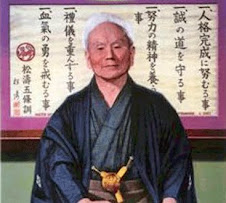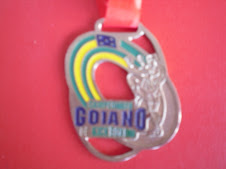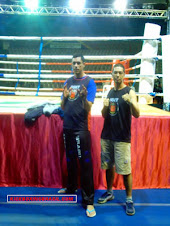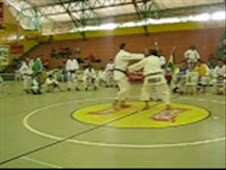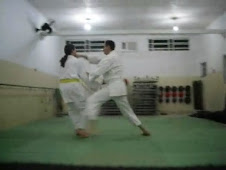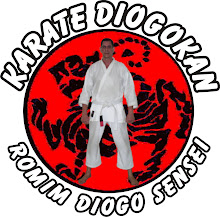sábado, 23 de fevereiro de 2013
como lutar
começou a luta:
- tome distância e repare de o adversário está fundo ou raso; eu prefiro me posicionar raso.
- repare se o adversário quer ficar parado esperando desferir um deai em você, ou se ele se movimenta querendo fintar e entrar na sua distância para deferir um golpe.
- no caso dele permanecer parado, você tem duas opções; se movimentar em onda neutra para que ele se mova e te proporcione uma onda ou saia e volte para a distância, ocasião em que você pode fazer a reversão de deai; ou então fazer o sabão para desferir um ataque ou tirar o deai dele e ataca-lo.
- no caso dele se movimentar tentando fazer finta, transforme a onda ativa dele em onda passiva sua, e desfira um renzoku waza.
- lembre -se que a da distância é que vai determinar sua atitude no jogo; se ele atacar fora da distância de deai, faça um mikiri usando o encurtamento de perna complementado com o taisabaki em y e a volta com oi komi gyaku tzuki.
se ele chegar na sua distância de deai, não espere ele atacar, desfira um oi komi gyaku tzuki e se precisar complemente com gyaku tzki.
se ele só chegar perto da sua distância de deai, pegue a onda dele e defira um renzoku waza, mas cuidado para só começar a sequencia quando ele estiver começando a voltar, pois do contrário ele pode te desferir um deai.
esse é a tática básica para você usar as chaves do karate diogokan. lógico que existem muitas outras opções de táticas, mas essa é a mais simples.
oss!
started the fight:
- Take note of distance and the opponent is deep or shallow, I prefer to position myself shallow.
- Notice if the opponent wants to sit still hoping to strike a deai you, or if it moves dribbling and wanting to join your distance to defer a coup.
- In his case remain still, you have two options; wave move in neutral for it to move and provide you a wave or exit and return to the distance, at which time you can make the reversal of deai, or do soap to launch an attack or take deai him and attack him.
- In his case move trying to feint, make it active in the wave wave his passive, and deliver a Renzoku waza.
- Remember that the distance will determine their attitude in the game if he attacks off the distance deai, make a mikiri using the shortening of leg complemented with taisabaki yea back in with hi komi gyaku zuki.
if he gets in his deai distance, do not expect him to attack, Deliver a hi komi gyaku zuki and if you need to supplement with gyaku tzki.
if he only get close to their distance deai, take it and wave to neglect a Renzoku waza, but be careful not to start the sequence when he's starting to come back, because otherwise it can get you strike a deai.
this is the basic tactic for you to use keys diogokan karate. course, there are many other options of tactics, but this is the simplest.
oss!
segunda-feira, 18 de fevereiro de 2013
as oito chaves do karate diogokan
THE EIGHT KEYS DIOGOKAN KARATE!
diogokan karate is a method invented by sensei Romim diogo to fight karate.
The method is divided into eight keys, distance, deai, the mikiri the bottom and shallow, the taisabaki, the waves, the search for iponn and scope of mental emptiness.
first key:
- The notion of distance is to be developed by the practitioner, since each has its own distance. you should know how far his punches the opponent with atigem efficiency and balance, as well as the distance the opponent can hit you.
their distance of arm or leg should be the same.
second key:
- The second is the key diogokan deai, and we deai is the defense of its distance; stepped on their distance, dies ...
third key:
- The third key is the mikiri, that is you leave your distance and then back to attacking after using a pendulum usually the base as step neko ashi.
* See that so far we deal with distance and time.
fourth key:
- The fourth key is shallow and the bottom, which is the notion of your position in relation to the alignment of the opponent.
you are shallow when your front foot is aligned with the front foot and back of the opponent when your front foot is aligned with the rear foot of the opponent. (Generally on all fights fighters stand fund in relation to your opponent).
when you are in position mirror background and shallow as they are in normal position.
background and shallow define which way you should turn the fight and also defines which way you should avoid if nescessário.
fifth key:
- In the diogokan quainta key is taisabaki, which is defined by observing the fourth key.
taisabaki is done with the deai or mikiri and always with an attitude of attack rather than defense.
the taisabaki is always done using ox imaginary.
diogokan in use six types of taisabaki.
sixth key:
- The sixth key observation is diogokan wave motion, which is identified to the time that the opponent has no traction and can not deliver the deai.
diogokan identifies the wave passive, or one that is caused by those who want to make the entry. comulmente this wave is called a "break time."
identified another wave is the wave passive, ie one that is caused by the opponent when it makes a feint or a shift forward and lose traction when it starts to come back.
Wave is a neutral observation status adopted by karateka diogokan where he moves without causing wave while the snake wave caused by the opponent.
a karateka diogokan only attacks when the opponent has no traction because he is fighting against the opponent deai.
seventh key:
- The seventh is the search for iponn because karate is not boxing and it can not be exchanged blows, karate is knife fight without knife and if it hover exchange of blows by opponents, both die.
when a lion kills a zebra, can not get hurt, because tomorrow he will have to kill another ...
Karate wazari is boxing!
eighth key:
- The octave key is to search through the void, ie the achievement of a feeling that is between fear and courage, and that is to fight using only the keys.
this key is achieved through training and practice.
AS OITO CHAVES DO KARATE DIOGOKAN!
karate diogokan é um método inventado pelo sensei romim diogo para lutar karate.
o método é dividido em oito chaves, a distância, o deai,o mikiri, o fundo e raso,o taisabaki,as ondas, a busca pelo iponn e o alcance mental do vazio.
primeira chave:
- a noção de distância deva ser desenvolvida pelo praticante, pois cada um tem sua própria distância. você deve saber a distância que seus golpes atigem o adversário com eficiência e equilíbrio, assim como a distância que o adversário pode te atingir.
sua distância de braço ou de perna deve ser a mesma.
segunda chave:
- a segunda chave do diogokan é o deai, e para nós o deai é a defesa da sua distância; pisou na sua distância, morre...
terceira chave:
- a terceira chave é o mikiri, que é vc abandonar sua distância e depois voltar atacando após fazer um pêndulo usando geralmente a base neko ashi como step.
* vejam que até agora lidamos com a distância e o tempo.
quarta chave:
- a quarta chave é o fundo e o raso, que é a noção do seu posicionamento em relação ao alinhamento do adversário.
você está raso quando seu pé da frente está alinhado com o pé da frente do adversário e fundo quando seu pé da frente estiver alinhado com o pé de trás do adversário. (geralmente em todas as lutas os lutadores se posicionam fundo em relação ao seu adversário).
quando você estiver na posição espelho,o fundo e o raso são como na posição normal.
o fundo e o raso definem para que lado você deve rodar a luta e também define para que lado você deve esquivar se nescessário.
quinta chave:
- no diogokan a quainta chave é o taisabaki, que é definido pela observação da quarta chave.
o taisabaki é feito com deai ou com mikiri e sempre numa atitude de ataque e não de defesa.
o taisabaki sempre é feito usando o x imaginário.
no diogokan usamos seis tipos de taisabaki.
sexta chave:
- a sexta chave do diogokan é a observação das ondas de movimento, para que seja identificado o momento que o adversário não tem tração e não pode desferir o deai.
o diogokan identifica a onda passiva, ou aquela que é causada por quem quer fazer a entrada. essa onda é comulmente chamada de "quebrar o tempo".
outra onda identificada é a onda passiva, ou seja aquela que é provocada pelo oponente quando esse faz uma finta ou um deslocamento para frente e perde a tração quando começa a voltar.
a onda neutra é um estado de observação adotado pelo karateca diogokan, onde ele se movimenta sem provocar onda e ao mesmo tempo cobra pela onda provocada pelo adversário.
um karateca diogokan só ataca quando o adversário não tem tração, pois ele luta é contra o deai do adversário.
sétima chave:
- a sétima é a busca pelo iponn, pois karate não é pugilismo e nele não pode haver troca de golpes; karate é luta de faca sem faca e nela se hover troca de golpes pelos oponentes , os dois morrerão.
o leão quando mata a zebra, não pode se machucar, pois amanhã ele terá que matar outra...
karate de wazari é pugilismo!
oitava chave:
- a oitava chave é a busca pelo vazio, ou seja o alcance de um sentimento que está entre o medo e a coragem, e se consiste em apenas lutar usando as chaves.
essa chave é alcançada através do treino e da prática.
Assinar:
Postagens (Atom)

